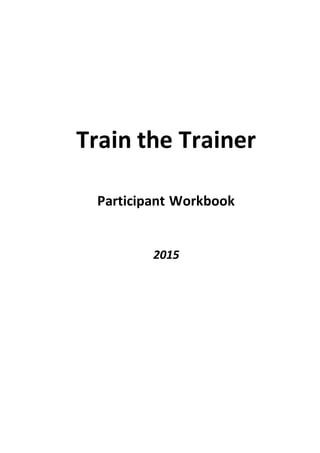
Train-the-Trainer Workbook
- 1. Train the Trainer Participant Workbook 2015
- 2. TABLE OF CONTENTS 1. Course Welcome / Intro to Adult Learning Principles 1 2. Fundamental Teaching Techniques 5 3. Good Communication 7 4. Engaging Your Learners 13 5. Leading Learning Activities 19 6. Managing the Classroom 21 7. Course A-Ha’s 27
- 3. 1 Module 1 Course Welcome – Adult Learning Principles Learning Objectives for This Module: Describe at least one technique for opening training courses. Identify at least one technique for making non-interactive content more interactive. Create one personal learning objective for the course. Welcome to the “Train the Trainer” session! Our goal is to help you become a world-class teacher who has a real impact on students. You’ll get a chance to see and use some training best practices from across the industry, grounded in adult learning theory. You might not end up using all of these approaches and techniques all of the time, but our goal is to give you a good “toolbox” of adult-learning ideas…so you can pick what will work best for you and in specific teaching situations. Introduction Exercise What did you notice about how we just did introductions? Why are introductions important in training? How can a teacher build credibility and rapport at the beginning of training? What would you do in a room of 15 learners?
- 4. 2 Helpful Teaching Tips Make sure exercises have a time limit and move quickly. Never ask for more than three pieces of output at a time. Give multi-sensory instructions – verbal and written Show your students what you would like to see: demonstrate the task for them yourself! Build credibility and rapport with your students through introductions and warmth…not by giving them your resume. Give students something to do from the moment they arrive in class – get them engaged in the training right away! Course Roadmap Course Introduction (GMI) Teaching Skill (Marci, CCC) Adult Learning Principles Fundamental Teaching Techniques Good communication LUNCH Teaching Skill (Marci, CCC) Engaging Your Learners Leading Learning Activities Managing the Classroom Wrap up & Closing (GMI) We assume you have cleared your calendarso you can be fully committed and present for our training. If you have a competing need that comes up during ourtime together, please let us know so we can work with you!
- 5. 3 Course Objectives Overall: By the end of this course, all students should be able to: Build an action plan applying at least three adult-learning techniques to improve the effectiveness of your classroom teaching. Building Blocks: We will achieve this overall goal by helping you to do these specific tasks: Create a complete, effective, and learner-oriented learning objective statement. Choose from the three teaching techniques to meet unique teaching situations. Use the four built-in tools, questioning, and storytelling techniques to engage learners. Practice the ten key elements of setting up and debriefing learning activities. Apply classroom management techniques to address common classroom situations. Building Your Own Personal Learning Objective Consider the upcoming course you will teach, and your own personal experience as a teacher. Think about the objectives for this training session – what you will learn today Based on these things, write a personal learning objective in the space below– what you hope to achieve during our time together. Make sure your objective is SMAC: Specific, Measurable, Achievable, and Compatible.
- 6. 4 Helpful Teaching Tips Always give your students a chance to think through what they want to learn in a course – even in a short session, it’s a good idea to spend 3-5 minutes on this! Start with the course objectives, before asking students to develop their personal objectives: o Sets boundaries for students. o Avoids mismatch of expectations versus actual content o Helps students understand where you are leading them. For a small class, how would you lead this discussion versus a class which is very large? How would you lead a “Personal Learning Objectives” discussions in both situations? Ground Rules Activity Capture your notes from this Activity here. Debrief Questions Why are Ground Rules important? How could you set up Ground Rules differently in large and small groups?